(MENAFN- ProactiveInvestors)
Is there anything can’t do
First it revolutionized the personal computing business. Then with the launch of the iPod in 2001 it forced the music industry to change its tune. Against initial market reservations the company succeeded at making Star Trek-like tablets hip when it released the iPad in 2010. And in Q1 2015 a record 75 million units of its now-ubiquitous iPhone were sold around the globe. The smartphone’s operating system iOS currently controls a jaw-dropping 89-percent share of all systems worldwide pushing the second-place OS ’s Android down to 11 percent from 30 percent just a year ago.
As you might already know the company that Steve Jobs built—which we own in our All American Equity Fund (GBTFX) andHolmes Macro Trends Fund (MEGAX)—is history’s largest by net capitalization. In its last quarterly report posted a record $75 billion in revenue and is now sitting pretty on a mind-boggling $180 billionin cash. Many analysts believe the company will reach a jaw-dropping $1 trillion in market cap.
So what’s ’s next trick
How about moving the world’s gold market
iGold
This April will be venturing into the latest wearable gadget market the smartwatch joining competitors such as Samsung and . All of the models in ’s stable of watches look sleek and beautifully designed—just what you’d expect from —and will no doubt be capable of performing all sorts of high-tech functions such as receiving text messages monitoring the wearer’s vitals and of course telling time.
But the real story here is that the company’s high-end luxury model referred to simply as the Watch Edition will come encased in 18-karat gold.
What should make this news even more exciting to gold investors is that the company expects to produce 1 million units of this particular model per month in the second quarter of 2015 alone according to the Wall Street Journal.
That’s a lot of gold if true. It also proves that the Love Trade is alive and well. chose to use gold in its most expensive new model because the metal is revered for its beauty and rarity.
To produce such a great quantity of units how much of the yellow metal might be needed
For a ballpark estimate I turn to Apple news forum TidBITS which begins with the assumption that each Watch Edition contains two troy ounces of gold. From there:
If makes 1 million Watch Edition units every month that equals 24 million troy ounces of gold used per year or roughly 746 metric tons [or tonnes].
That’s enough gold to make even a Bond villain blush but just how much is it About 2500 metric tons of gold are mined per year. If uses 746 metric tons every year we're talking about 30 percent of the world's annual gold production.
To put things in perspective the Sripuram Golden Temple in India the world’s largest golden structure is made from “only” 1.4 million tonnes of the metal.
TidBITS acknowledges that the amount of gold is speculative at this point. But even if each luxury watch contains only one troy ounce it’s still an unfathomable—perhaps even unprecedented—amount of gold for a single company even one so large as to consume.
Ralph Aldis portfolio manager of our Gold and Precious Metals Fund (USERX) and World Precious Minerals Fund (UNWPX) likens the idea of buying a third of the world’s gold to China’s voracious consumption of the metal. As I mentioned last week China is buying more gold right now than the total amount mined worldwide.
“If the estimates of how much gold each watch contains are close to reality and if ’s able to sell as many units as it claims it really ought to help gold prices move higher” Ralph says.
But Can Expectations Be Met
Here’s where this whole discussion could unravel. Although we don’t yet know what the Watch Edition will retail at it’s safe to predict that it will fall somewhere between $4000 and $10000 placing it in the same company as a low-end Rolex.
With that in mind are ’s sales expectations too optimistic
Possibly. But remember this is we’re talking about here. Over the years it has sufficiently proven itself as a company that more-than-delivers on the “if you build it they will come” philosophy. Steve Jobs aggressively cultivated a business environment that not only encourages but insists on “thinking different”—to use the company’s old slogan—risk-taking and developing must-have gadgets.
“Our whole role in life is to give you something you didn’t know you wanted” says current CEO Tim Cook. “And then once you get it you can’t imagine your life without it.”
A perfect case study is the iPhone. When it launched in June 2007 the cell phone market was decidedly crowded. Consumers seemed content with the choices that were already available. Why did we need another phone
Yet here we are more than eight years later and as I pointed out earlier 75 million iPhones were sold in the last quarter alone.
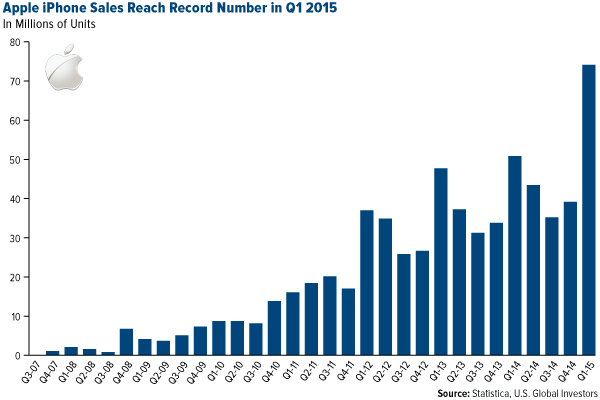
click to enlarge
So it’s not entirely out of the realm of possibility for to move 1 million $10000 Watch Editions per month.
Early in January I shared the following chart which shows various analysts’ Watch shipment forecasts for 2015 ranging from 10 million to 60 million units. Of course all models are included here not just the luxury model.
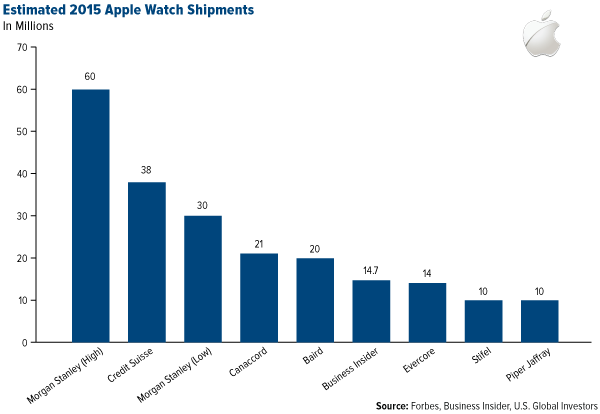
click to enlarge
Looking at it now many of the predictions seem a little understated. After all hasn’t released a dud product in at least two decades (remember the Newton). Come April we’ll see for sure what the demand really is—for the Watch as well as gold.
Global Metals & Mining Conference
Last weekend I attended the BMO Metals & Mining Conference in Hollywood Florida along with Ralph Brian Hicks a portfolio manager of our Global Resources Fund (PSPFX) and junior analyst Alex Blow.
“Generally speaking companies have streamlined operations and are focused on shareholder returns” Brian said.
Alex came away from the conference with renewed conviction that the global climate is conducive for gold citing central bank easing policies and increasing volatility in world currencies both of which support the yellow metal’s performance.
“It looks as though gold has technical support and that a bottom has been reached” he said. “If the eurozone really picks up gold demand should rise which would also benefit China since its primary gold export destination is the eurozone.”
Mark Your iCalendar
I invite everyone to join us during our next webcast to be held this Wednesday March 4 at 4:30 PM ET/3:30 PM CT. The discussion will center on our Near-Term Tax Free Fund (NEARX) which has delivered 20 straight years of positive returns. We hope you can make it!
Yes sign me up for the webcast!

Index Summary
- The major market indices finished mixed this week. The Dow Jones Industrial Average dropped 0.04 percent. The S&P 500 Stock Index fell 0.27 percent while the Nasdaq Composite moved higher by 0.15 percent. The Russell 2000 small capitalization index rose 0.12 percent this week.
- The Hang Seng Composite rose 0.28 percent; Taiwan advanced 0.97 percent this week and the Korean KOSPI gained 1.24 percent.
- The 10-year Treasury bond yield fell 12 basis points to 1.99 percent.

Domestic Equity Market
The S&P 500 took a small step back this week as cyclical areas of the market took a breather after a good run in recent weeks. Telecommunication services and consumer staples led the market this week while energy lagged.
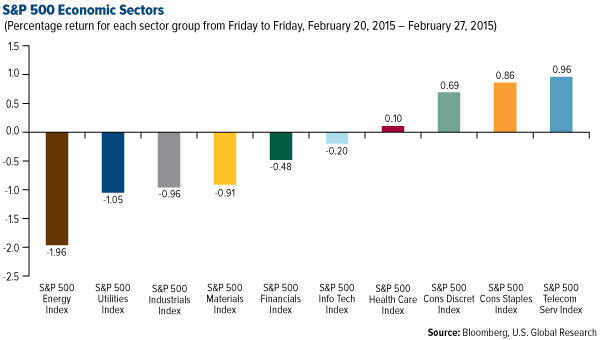
click to enlarge
Strengths
- The telecommunication services sector was the best performer this week rising almost 1 percent. AT&T and Verizon were the leaders on the back of the contentious net-neutrality ruling. Net neutrality requires internet service providers to act as neutral gateways very similar to how telecommunication service providers operate.
- The consumer staples sector was also strong as airlines and aircraft-related areas outperformed. Monster Beverage rose by more than 16 percent as the company beat analysts’ estimates. The company is seeing success in rolling out new products and expanding its distribution partnership with Coca-Cola which also had a good week.
- First Solar was the best performer in the S&P 500 this week rising by 21.88 percent. The company announced earnings this week but the real driver was the announced partnership with to form a “YieldCo” joint venture. This partnership would likely spinout steady cash flow producing parts of the business that would garner a higher valuation than if consolidated within the existing companies.
Weaknesses
- The energy sector was the worst performer for the second week in a row as oil prices declined as oil inventories continued to build. The natural gas producers and offshore-related companies were among the worst performers.
- The utilities sector was also a poor performer this week even as weather and bond yields have been moving in the right direction for it. The sector had a very strong run from October through January and is likely just consolidating some of those gains.
- was the worst performing company in the S&P 500 this week falling 17.83 percent. The company disclosed that its exploration and development budget would outspend cash flow by roughly $2.5 billion over the next two years. This relatively aggressive spending plan raises the risk profile of the company.
Opportunities
- Cyclicals outperformed in February as improving global growth prospects provide a lift. If China and Europe continue to improve the trend is likely to persist.
- A strong dollar continues to benefit domestic consumers maintaining an advantage for certain U.S.-focused retailers and consumer products.
- With both ISM manufacturing and employment data out next week strong results would likely reinforce the recent trend of a self-sustaining economy and would be supportive of market valuations.
Threats
- Consumer sentiment indicators were mixed this week and it is a little surprising that the low oil price gasoline “tax cut” is not having a bigger impact on consumer spending patterns.
- An improving global economy and U.S. economic data that supports an improving job market may very well be enough to allow the Fed to raise rates as soon as June.
- Defensive plays should be monitored closely now that yields have turned the corner and investor sentiment is more positive.

The Economy and Bond Market
Intermediate and long-term U.S. Treasury bond yields moved lower this week while shorter-term treasuries were little changed. Chair Janet Yellen was in front of Congress this week and while the market initially viewed her comments as neutral other Fed members painted a picture of a more hawkish stance than the market raising the likelihood of an interest rate increase in the early fall. This is all very interesting especially given the fact that year-over-year inflation measures went into negative territory in January which historically is an unusual event. European economic data is improving even though you may not have guessed that if you listen to the news channels and China continues to suggest that more easing is on the way. The Fed probably believes that these two things provide a window of opportunity to begin the process to “normalize” interest rates.
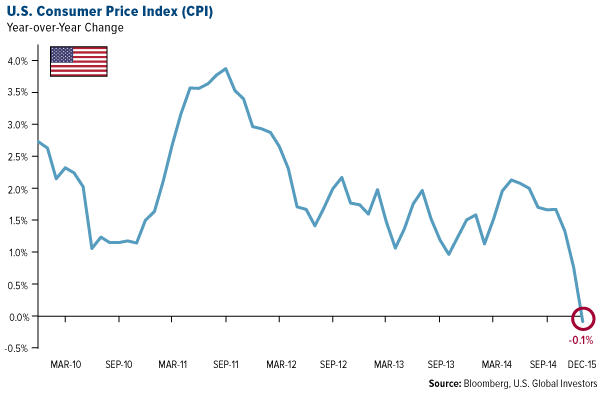
click to enlarge
Strengths
- China’s flash purchasing managers’ index (PMI) rose to a four-month high and crossed back into expansion territory. This is significant for the global growth outlook as China’s economy appears to be improving at the same time Europe is picking up.
- Both eurozone and U.S. inflation are in deflation and under almost any historical scenario the Fed would not raise interest rates in such an environment but we are in uncharted territory.
- European economic data positively surprised again this week; for example Germany’s Ifo index business confidence survey made a six-month high. Other measures of economic activity have also improved across the continent.
Weaknesses
- TJ Maxx announced that it would match Wal-Mart’s pay raises that were announced recently. The Fed likely is closely monitoring wage pressure as a trigger for labor market tightness. This could be one of the reasons for its recent confidence that higher rates are warranted.
- Both new and existing home sales were lackluster in January which is inconsistent with an improving labor market.
- In an interesting twist the long end of the yield curve rallied this week even as the consensus interpretation of the Fed was more hawkish. This also occurred in January and it appears that the market believes if the Fed follows through with rate increases the economy will suffer and increases will be short lived.
Opportunities
- Europe appears to be rapidly improving and may positively surprise in 2015.
- China’s inflation recently hit a five-year low. The central bank recently lowered the reserve requirement for banks (easing policy) and is expected to do more in the near future as inflation remains muted.
- Yields in the U.S. remain the highest in the developed world and funds will likely continue to flow into U.S. fixed income.
Threats
- One of the themes from the recent earnings season was that the strong U.S. dollar has negatively impacted companies’ bottom lines and that will likely be the case for the first quarter as well.
- The employment report will be released next Friday. A strong report will reinforce the Fed’s view that the economy is strong enough to handle normalization of interest rates.
- Fed speakers were very active this week in pushing the idea that the Fed would raise interest rates in 2015.

Gold Market
For the week spot gold closed at $1212.90 up $10.95 per ounce or 0.91 percent. Gold stocks as measured by the NYSE Arca Gold Miners Index gained 3.72 percent. The U.S. Trade-Weighted Dollar Index gained 1.07 percent for the week.
| Date | Event | Survey | Actual | Prior |
| Feb-24 | Europe Core YoY | 0.60% | 0.60% | 0.60% |
| Feb-24 | U.S. Consumer Confidence Index | 99.5 | 96.4 | 102.9 |
| Feb-24 | HSBC China Manufacturing PMI | 49.5 | 50.1 | 49.7 |
| Feb-25 | U.S. New Home Sales | 470K | 481K | 481K |
| Feb-26 | Hong Kong Exports YoY | 1.30% | 2.80% | 0.60% |
| Feb-26 | U.S. YoY | -0.10% | -0.10% | 0.80% |
| Feb-26 | U.S. Durable Goods Orders | 1.60% | 2.80% | -3.40% |
| Feb-26 | U.S. Initial Jobless Claims | 290K | 313K | 283K |
| Feb-27 | German YoY | -0.30% | 0.10% | -0.40% |
| Feb-27 | U.S. GDP Annualized QoQ | 2.00% | 2.20% | 2.60% |
| Mar-1 | HSBC China Manufacturing PMI | 50.1 | - | 50.1 |
| Mar-2 | Europe Core YoY | 0.60% | - | 0.60% |
| Mar-2 | U.S. ISM Manufacturing | 53 | - | 53.5 |
| Mar-4 | U.S. ADP Employment Change | 218K | - | 213K |
| Mar-5 | ECB Main Refinancing Rate | 0.05% | - | 0.05% |
| Mar-5 | U.S. Initial Jobless Claims | 295K | - | 313K |
| Mar-6 | U.S. Change in Nonfarm Payrolls | 235K | - | 257K |
Strengths
- Gold rebounded from the lowest level in seven weeks following Chair Janet Yellen’s comments signaling that an interest rate increase isn’t imminent. Analysts are now coalescing around September for an initial rate hike.
- Gold climbed to the highest in a week after Chinese buyers returned from holidays and investors speculated the Fed will continue to keep rates low. Volumes for the Shanghai Gold Exchange’s benchmark spot contract more than doubled on Wednesday as investors in China returned from the week-long Lunar New Year holiday.
- Gold futures bounced back after a government report showed that the U.S. economy expanded at a slower pace than previously estimated in the fourth quarter. The U.S. grew at a 2.2 percent annualized rate lower than the initial 2.6 percent estimate.
Weaknesses
- Gold could be heading for its biggest monthly drop since September. This comes amid concern that U.S. borrowing costs will rise along with the bailout deal reached for Greece curtailing demand for the safe-haven metal.
- The gold and silver fixes along with other commodity benchmarks have come under increased scrutiny by regulators in both Europe and the U.S. since a London Interbank Offered Rate manipulation case in 2012. Furthermore Switzerland’s competition commission WEKO is probing possible manipulation of price fixing in the precious metals market.
- HSBC and are among at least 10 international banks being investigated by the U.S. Department of Justice for alleged rigging of the precious metals market. The Gold Anti-Trust Action Committee is claiming that precious metals prices are being heavily manipulated by the big commercial banks in collusion with the U.S. Fed and other central banks.
Opportunities
- Nick Barisheff CEO of Bullion Management Group claims that between 2000 and 2015 the U.S. debt and the gold price have had a positive correlation of 93.7 percent. However since 2012 the relationship has decoupled. To get back to the correlated relationship the gold price would have to return to around $1800 implying that gold is undervalued at current levels.
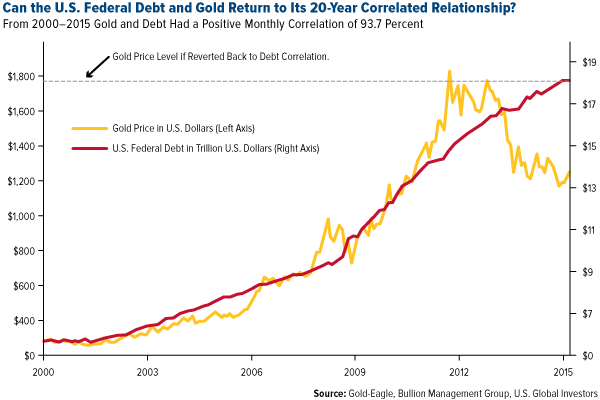
click to enlarge
- announced it has entered into a joint venture with for the development of Orex’s Barsele gold project in Sweden. The proposed joint venture would see Agnico-Eagle earn 55 percent of the project through the payment of $10 million and would also see the company commit to spend $7 million on the project over the next three years. What is interesting is that has a $30 million market cap so the $10 million put up by Agnico-Eagle represents about one-third of Orex’s market value. Orex also has three other projects one which is already in a joint-venture agreement with Fresnillo. The management team at Orex has again proven that it is adept at structuring deals as it had previously arranged for Orko Silver to be sold to First Majestic only to be outbid by .
- The recently published 2014 Fraser Institute Survey ranks Finland Saskatchewan Nevada Manitoba Western Australia Quebec Wyoming Newfoundland and Labrador the Yukon and Alaska as the top 10 jurisdictions for mining investment.
Threats
- That same survey mentioned above also ranked Malaysia Hungary Kenya Honduras Solomon Islands Egypt Guatemala Bulgaria Nigeria and Sudan as the least attractive jurisdictions for mining investment.
- The central banks of Switzerland Sweden and Denmark are now imposing negative interest rates on bank deposits. Analysts at Commonwealth Bank of Australia claim that almost a quarter of worldwide central bank reserves now carry a negative yield. The risk is that negative rates backfire and could result in even lower demand. Additionally Citigroup said in a report last month that “there are no serious arguments against creating a financial system where nominal rates can be set with equal ease at negative 5 percent as at 5 percent.”
- Sibanye Gold and Harmony Gold Mining have been trying unsuccessfully for at least a decade to link pay increases to efficiency gains. They will try again by lobbying for this in the wage negotiations with employees set to begin in April.
 |
![[thumb]](http://www.usfunds.com/tasks/render/file/fileID=CB094129-9F84-F0B3-F770006A401DD742&fileEXT=.jpg) February 26 2015 Why We Invest in Royalty Companies | ![[thumb]](http://www.usfunds.com/tasks/render/file/fileID=32BC2E11-069F-1716-971FD7259AC2763B&fileEXT=.jpg) February 23 2015 Why Bad News Is Good News in Europe-7 Charts Showing What You Really Need to Know |

Legal Disclaimer:
MENAFN provides the information “as is” without warranty of any kind. We do not accept any responsibility or liability for the accuracy, content, images, videos, licenses, completeness, legality, or reliability of the information contained in this article. If you have any complaints or copyright issues related to this article, kindly contact the provider above.
Market Research

- Process Analyzer Market Trends, Size, Share, Analysis, 2024-2032 | IMARC ...
- Cold Pressed Oil Market Trends 2024, Leading Companies Share, Size And Fo...
- Metal Fabrication Equipment Market Outlook 2024, Share, Size, Key Players...
- Saudi Arabia Fiber Optics Market Trends, Scope, Demand, Opportunity And F...
- Saudi Arabia Hybrid Cloud Market To Witness 21.91% CAGR Until 2032...
- Social Commerce Market Trends, Size, Share, Analysis, 2024-2032 | IMARC G...
- Machine Vision Market Size, Growth, Demand, Top Companies And Forecast 20...
|